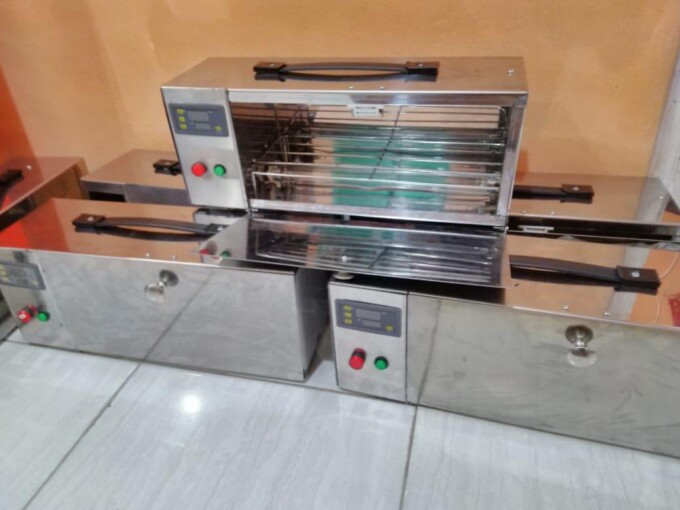
There is a high surge in the scarcity and price of the N95 mask that rose during this pandemic. Therefore, the UGM research team developed an N95 mask sterilizer so that the masks could be used repeatedly in hospitals and health clinics. Utilizing the power of ultraviolet C (UV-C) light that is flashed for five minutes, this tool can kill germs and Covid-19 virus in masks that have been used before.
Dr. Trisasi Lestari, MD., M.Med.Sc, as a member research team from the Faculty of Medicine, Public Health, and Nursing (FKKMK) UGM, said that the manufacture of this tool was in collaboration with researchers from the UGM Faculty of Engineering. The idea is initiated from the difficulty of making the medical staff in getting N95 masks on the market. “The rising price of N95 masks is very costly in the Covid-19 era. It is up more than ten times from the regular price. In fact, before Covid-19, the cost of N95 masks was indeed more expensive than surgical masks because of its better filter function,” she said in a conversation with reporters on Wednesday (5/13).
According to her, the scarcity of N95 masks is not only happening in Indonesia but also throughout the entire world WHO World Health Organization has allowed the use of N95 masks repeatedly by sterilizing them first until the masks look dirty or damaged. “Ideally, we use it in no more than three times sterilization. Many hospitals make N95 mask sterilizers, but without calculating the strength of the UVC lamp or a long exposure period, the mask is damaged. We were also encouraged to make a UVC sterilizer specifically designed for N95 masks,” she said.
She supposed it is not only at current Covid-19, but the idea for the sterilization of N95 masks has also been around for a long time since he dealt with many patients with Tuberculosis (TB). “To treat MDR TB patients must use an N95 mask. The availability is also limited, and one mask can be worn for up to one week by TB officers at the puskesmas by only hanging in the sun to sterilize it due to limited facilities,” she said.
Even so, she was grateful that, currently of this pandemic, the idea was realized by collaborating with other researchers from the UGM Faculty of Engineering. “I proposed making it to a group of engineering lecturers. I am grateful that it was welcomed and supported by Eka Firmansyah and her guidance students to realize the tools,” she explained.
She said the process of making this tool began in early April and finished within one month. The tool made in two sizes that can hold 3 or 9 masks at once. According to her, the selection of UV-C ultraviolet light waves used mature consideration. Thus, it will not damage the quality of the mask when sterilized. “We use UV-C light waves with wavelengths between 250-270nm, proven to be able to directly damage the DNA and RNA of bacteria or viruses so that the effect is deadly bacteria and viruses themselves,” she said.
The mask sterilization process using UV-C ultraviolet light exposure only takes about five minutes to kill germs and viruses that stick. “For the box that we made with a sterilization time of 5 minutes, it has proven that there are no germs grow,” Trisasi explained.
She added, this sterilizer could not only be intended for masks, but could also be used in other medical devices such as scissors, scalpels, and gauze. “The effective duration of exposure has not been measured. However, the assumption with 5-10 minutes of exposure is deadly enough,” she said.
Trisasi said that this tool planned to be distributed first to several puskesmas and hospitals in Jogja, including the Microbiology Lab FKKMK, where the tool tested. The plan for this tool will continue to be developed so that it can be mass-produced. “Hopefully, it can be produced at a lower price as well so that it is affordable and can be available in all puskesmas and other health facilities in Indonesia,” she hoped.
While other research members Dr. Eka Firmansyah from the UGM Engineering Faculty, said that sterilization by using ultraviolet-C (UV-C) light is one of the usual methods for decontaminating bacteria or viruses. “Exposure to UV rays with the right dose, not excessive, can reduce the risk of damage to the N95 mask filter, so it is safer to use it repeatedly,” she said.
Eka said that he made two designs; the first type is the internal dimensions of 40 cm x 40 cm x 30 cm and the external dimensions of 40 cm x 40 cm x 40 cm. This dimension allows sterilization with a volume of 48 liters, which can sterilize 9 N95 masks. The second type with external dimensions of 35 cm x 15 cm x 15 cm and external dimensions 45 cm x 15 cm x 17 cm. This dimension has a sterilization booth with a capacity of 7.8 liters, which can sterilize 3 N95 masks.
Eka said the process of UV Box tool production is being carried out by the startup company MicroMachina which was founded by a group of UGM Engineering students. It is also supported by alumni of the Faculty of Medicine UGM in 1998 by donating several boxes to hospitals and puskesmas in need in Yogyakarta.
Author: Gusti Grehenson
Translator: Natasa A

